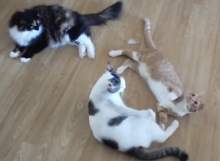
Until now, search and rescue robots have been mainly tracked and either self-righting or able to operate either side up to enable them to cope with uneven terrain and falling from heights. With animal and human inspired legged robots on the rise, researchers are looking to ways to help them land safely then quickly resume their mission.
Scientists at Georgia Tech School of Interactive Computing were inspired by the animals and people who always land on their feet – cats and athletes like Parkour experts – to develop ways to help robots do the same.
In a DARPA-funded project, associate professor Karen Liu studied the physics of diverse subjects from falling cats to the mid-air orientation of divers and astronauts to help reduce impact in falling robots that could in future be used for search-and-rescue missions in hazardous conditions.
"It’s not the fall that kills you. It’s the sudden stop at the end," Liu said. "One of the most important factors that determine the damage of the fall is the landing angle."
As current computer processing and robot servo technology would not enable robots to calculate and shift into a safe landing angle in time, Liu and her colleagues tested elements of the fall and landing using a small two-legged robot on an angled air-hockey table.
The researchers next want to teach a robot the skill of orientation and impact, a feat that falling humans cannot achieve but cats perform naturally.
Follow Berenice Baker on Google+


.gif)

